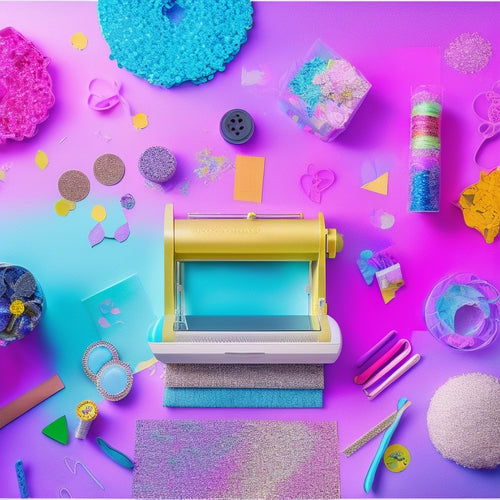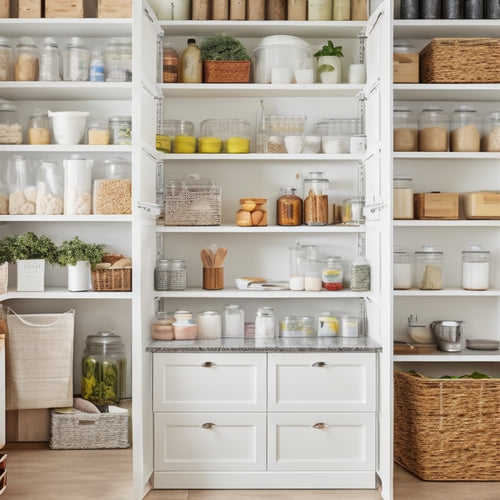
How to Install an Above Sink Bathroom Shelf in 10 Easy Steps
Share
You'll start by preparing your bathroom area, clearing clutter and evaluating existing storage solutions. Next, measure your sink and wall, noting obstacles and recording the height for your desired shelf position. Choose the right shelf type and material, then gather necessary tools like a drill and level. Mark the wall for drilling, then attach shelf brackets, ensuring they're secure and level. Secure shelf supports, then place the shelf on the brackets, adding decorative trim if desired. Finally, inspect and touch up your installation, and you'll be ready to see how all the details come together.
Key Takeaways
- Prepare the bathroom area by clearing clutter and assessing existing storage solutions to ensure a safe and harmonious workspace.
- Measure the sink and wall accurately to determine the right shelf size and anchor type, and to avoid costly mistakes.
- Choose the right shelf type and material that matches the bathroom design style and enhances both style and utility.
- Use a level and proper drilling techniques to mark and drill holes for brackets, ensuring wall integrity and avoiding damage.
- Secure shelf brackets and supports carefully, respecting electrical outlets, plumbing fixtures, and weight capacity for a safe and functional installation.
Prepare the Bathroom Area
Clear the bathroom area of any clutter, toiletries, and towels to guarantee a safe and unobstructed workspace. You don't want to be dodging hair dryers and toothbrushes while trying to hang a shelf, trust us.
This is your chance to momentarily ignore the mess and focus on the task at hand.
Next, assess the bathroom aesthetics and take note of any existing storage solutions. Are there cabinets, drawers, or other shelves already in place?
Take stock of what you've got and think about how your new shelf will fit into the overall layout. You're not just installing a shelf, you're creating a harmonious bathroom ecosystem!
Now, grab a trash bag and get rid of any unnecessary items that are just taking up space.
Be ruthless – if you haven't used it in the past month, it's probably safe to toss it.
With a clear and clutter-free area, you're ready to move on to the next step.
Measure the Sink and Wall
With tape measure in hand, stand in front of the sink and identify the area where you plan to install the shelf.
Take note of the sink dimensions, including its width, length, and distance from the wall. You'll need these measurements to guarantee your shelf fits snugly above the sink.
Next, inspect the wall material to determine the type of anchors or screws you'll need. Is it drywall, tile, or concrete? This will affect the type of hardware you'll use to secure the shelf.
- Record the width of the sink and the distance from the wall to the center of the sink.
- Measure the height of the wall from the top of the sink to the desired shelf position.
- Note the type of wall material and any obstacles, such as electrical outlets or plumbing fixtures.
Remember to double-check your measurements to avoid any costly mistakes.
With your measurements in hand, you're ready to move on to the next step: choosing the right shelf for your bathroom.
Choose the Right Shelf
You'll typically find yourself selecting from three main types of bathroom shelves: recessed, wall-mounted, and floating. Each type has its pros and cons, so consider your bathroom's unique needs before making a decision.
Recessed shelves are ideal for small bathrooms, as they create the illusion of more space. Wall-mounted shelves are perfect for bathrooms with limited wall space, while floating shelves add a touch of modernity.
When it comes to shelf materials, you're spoiled for choice. Glass shelves add an air of sophistication, while wooden shelves bring warmth to the space. Metal shelves, on the other hand, exude industrial chic.
Consider your bathroom's design style when selecting a material. For instance, a modern bathroom would pair perfectly with a sleek metal shelf, while a traditional bathroom would benefit from a wooden shelf.
Lastly, think about the shelf's functionality. Do you need a shelf with built-in storage or one with a built-in LED light?
Consider your bathroom's specific needs and choose a shelf that fits the bill. By considering these factors, you'll find the perfect shelf to enhance your bathroom's style and functionality.
Gather Necessary Tools
Your toolbox is about to become your new best friend as you commence on this bathroom shelf installation expedition.
You'll be working with various shelf materials, from wood to glass, so it's crucial to have the right tools for the job. Remember, tool safety is paramount, so make certain you're familiar with each tool's proper usage.
You'll need the following essentials to get started:
- A drill with screwdriver and drill bits
- A level to guarantee your shelf is perfectly horizontal
- A tape measure to accurately calculate distances and markings
Don't bother rummaging through your toolbox just yet; we'll get to the specific tools required for each step later on.
For now, just verify you have these basics within arm's reach. With your tools at the ready, you're one step closer to turning your bathroom into a sleek, organized oasis.
Mark the Wall for Drilling
Mark the Wall for Drilling
Two marks on the wall will serve as guides for drilling, guaranteeing your shelf's brackets are securely fastened. To get it right, you'll need to measure carefully and mark the wall accurately.
Take your shelf's bracket and place it against the wall where you want it to go. Use a level to verify it's straight, then mark the spot where the screw will go with a pencil. Move the bracket to the other side of the sink and repeat the process. You should now have two marks on the wall.
| Measurement | Marking | Why |
|---|---|---|
| Shelf width | Center mark | Guarantees bracket is centered |
| Bracket screw hole | Small mark | Guides drilling for screw |
| Level line | Straight line | Verifies shelf is straight |
Remember to double-check your measurements and markings before moving on to the next step. You don't want to end up with wonky shelves or worse, damaged walls! With these marks in place, you're ready to start drilling.
Drill Holes for Brackets
With the marks in place, grab your drill and let's get started. You're about to make some holes, and we're not talking about the ones in your favorite sweater.
When drilling, use proper drilling techniques to avoid damaging the wall materials. For example, if you have drywall, use a drywall anchor to prevent the screw from slipping out.
Here are some tips to keep in mind:
- Use a level to confirm your drill is straight
- Apply gentle to moderate pressure, depending on the wall material
- Don't press too hard, or you might end up with a hole in your wall (and not the good kind)
Once you've drilled the holes, take a step back and admire your handiwork. You should see a neat, clean hole where your bracket will soon sit.
Attach Shelf Brackets
You'll now attach the shelf brackets to the wall, ensuring they're level and aligned with the holes you drilled earlier.
Pay attention to bracket placement, as it's essential for a sturdy shelf - you'll want to position them so they can support the weight of the shelf and any items you plan to store.
Secure the shelf supports by screwing them into place, making sure they're tightly fastened to the wall.
Bracket Placement Tips
Three key areas to focus on when placing shelf brackets are the wall studs, electrical outlets, and plumbing fixtures.
You want to guarantee your shelf can hold the weight of the items you plan to store, so it's vital to choose the right spot.
When selecting a location, keep in mind the following:
-
Avoid electrical outlets: You don't want to drill into any wires or compromise the outlet's functionality.
-
Respect plumbing fixtures: Make sure you're not drilling into pipes or compromising the sink's water supply.
-
Target wall studs: These provide the most support for your shelf, especially if you're planning to store heavier items.
Secure Shelf Supports
Two sturdy shelf brackets are all that stand between your new bathroom shelf and a cluttered countertop. You've got this far, so don't let your shelf come crashing down!
Now, it's time to secure those shelf supports. Hold the bracket against the wall, ensuring it's level and aligned with your marks from earlier. Use a pencil to mark the screw holes.
If you're dealing with drywall, use wall anchors to prevent the screws from stripping. For tile or glass walls, use the appropriate wall anchors or screws designed for those materials.
Drill pilot holes for the screws, then attach the bracket to the wall. Make sure it's snug and even.
Repeat the process for the second bracket, ensuring it's identical to the first. Remember to factor in the shelf weight when choosing the type of screws or anchors. You don't want your shelf to collapse under the weight of your toiletries!
With both brackets securely in place, you're ready to move on to the final step.
Place the Shelf on Brackets
With the brackets securely fastened to the wall, it's time to position the shelf on top of them. Confirm the shelf materials, whether glass, wood, or metal, are compatible with the bracket types you've chosen.
Now, carefully lift the shelf and align it with the brackets. You'll want to verify the shelf is level and even, so take your time and double-check your work.
Here are a few tips to keep in mind:
- If your shelf has a lip or overhang, make certain it's facing the correct direction to avoid any obstructions.
- Check that the shelf is securely seated on the brackets, with no wobbling or movement.
- Take a step back and visually inspect the shelf's position to confirm it's straight and even.
Add Decorative Trim (Optional)
Adding a decorative trim can enhance the overall aesthetic of your bathroom shelf. It's a great way to add a personal touch and make your shelf stand out. You can choose from a variety of decorative materials, such as wood, metal, or PVC, to match your bathroom's style.
Measure the edges of your shelf to determine how much trim you'll need. Cut the trim to size using a miter saw or a hacksaw, depending on the type of material you're working with.
Apply a thin layer of adhesive, such as hot glue or epoxy, to the back of the trim and press it firmly onto the shelf. Make sure to align it evenly and smooth out any air bubbles or excess adhesive.
Use a nail or staple gun to secure the trim in place, if necessary. Sand the edges to smooth out any rough spots.
Final Check and Touch-ups
Throughout the installation process, you've carefully measured, cut, and assembled the components of your bathroom shelf. Now it's time to confirm everything is perfect before calling it a day.
Double-check that your shelf is level and securely attached to the wall. You don't want it to come crashing down the moment you place a decorative vase on it!
Also, make certain all screws, nails, or adhesives are properly in place to maintain shelf stability.
Take a step back and evaluate the aesthetic appeal of your handiwork. Check for:
- Any gaps or unevenness in the trim or shelf boards
- Dust, dirt, or debris that might've accumulated during installation
- If the shelf is properly aligned with the surrounding fixtures and decor
If you notice anything amiss, take this opportunity to make adjustments or touch-ups as needed.
Frequently Asked Questions
Can I Install an Above Sink Shelf in a Small Bathroom?
You can totally install an above sink shelf in a small bathroom, as long as you prioritize space-saving solutions and consider aesthetic appeal - after all, who says tiny bathrooms can't be functional and fabulous?
How Do I Clean the Shelf Without Removing It?
Ah, you finally got that shelf installed, and now it's a dust-collecting haven! Don't worry, you don't have to remove it to clean it - simply use a extendable duster or a microfiber cloth with a gentle cleaning product, and follow these shelf cleaning techniques and maintenance tips to keep it sparkling!
Are Above Sink Shelves Suitable for Rental Properties?
You're wondering if above sink shelves are suitable for rental properties? Absolutely! They're a great way to add aesthetic appeal without making major changes, and you can easily remove them when you move out, considering rental property intricacies.
Can I Use a Shelf With a Non-Standard Sink Size?
You're wondering if you can use a shelf with a non-standard sink size? Measure your sink's dimensions, then choose a shelf with adjustable brackets or a customizable design to guarantee sink compatibility - problem solved!
Do I Need to Hire a Professional for Shelf Installation?
You don't need to hire a pro for shelf installation if you're comfortable with DIY tips like measuring, drilling, and leveling - but if you're not handy, it's better to call in the experts to avoid a wobbly shelf disaster!
Conclusion
You've made it! Your above sink bathroom shelf is now installed, and it's a revolutionary addition. Imagine a clutter-free countertop, with all your essentials neatly organized and within reach. You've got a sense of accomplishment, and your bathroom looks a million bucks! Take a step back, admire your handiwork, and enjoy the extra storage and style you've added to your bathroom.
Related Posts
-

Unleash Your Creativity: Cricut Projects Galore
Ignite your creativity with a Cricut machine, where beginners can start with fundamental projects like vinyl decals a...
-

Craft Your Own Hanging Organizer With Ease
To craft a functional and stylish hanging organizer, begin by gathering essential materials, including natural cotton...
-

Get Organized: Free Pantry Labels + More
I've learned the hard way that organization comes before labeling - a cluttered pantry with labels can actually look ...


